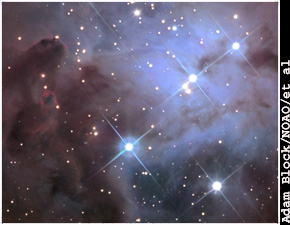Jupiter is the fifth planet from the sun. Its orbit is about 483 million
miles away from the sun. That's 5 times farther than Earth!
Jupiter would fit 11 Earths across its face. It is the biggest planet in
the solar system, and has a diameter of 88,846 miles.
It takes Jupiter 12 Earth years to go around the sun one time. So on your
twelfth birthday, Jupiter is in roughly the same place of the solar system as it was on the day you were born.
Although Jupiter takes a long time to go around the sun, it takes only
10 hours to spin on its axis one time. That's less than half the time it takes Earth to spin once.
Jupiter has a thin, faint ring.
The average temperature at the top of Jupiter's clouds
is -244°F.
Jupiter's atmosphere is made mostly of hydrogen (86%) and helium (14%).
The colorful cloud bands we see are actually cloud layers. Darker clouds tend to be deeper in Jupiter's atmosphere, while
the white clouds are higher. The atmosphere also has giant lightning storms in its upper clouds.
The Great Red Spot on Jupiter can be seen in a small telescope. This gigantic
storm would hold 2 Earths. The Red Spot has been around for more than 300 years.
To escape Jupiter's gravity you have to travel at 133,100 miles per hour.
Jupiter has 17 known moons. The four largest moons, Ganymede, Io, Europa, and
Callisto, are called the Galilean moons because Galileo first saw them in 1610.
Jupiter was the king of the Roman gods and lord of the sky, a fitting
name for our largest planet.

